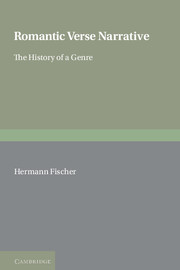Book contents
- Frontmatter
- Contents
- Preface
- List of abbreviations
- Dedication
- Introduction
- Part I The genre and it historical context
- Part II The history of the romantic tale in verse: poets, works, critics and the public
- 3 Early forms
- 4 The establishment of the genre by Sir Walter Scott, its fashionable period, and limitatins by other poets
- 5 ‘The postscript of the Augustans’ and the opposite of the romance
- 6 Ramification and dissolution
- 7 The subsequent fate of the genre
- Conclusion
- Notes
- Bibliography
7 - The subsequent fate of the genre
Published online by Cambridge University Press: 27 March 2010
- Frontmatter
- Contents
- Preface
- List of abbreviations
- Dedication
- Introduction
- Part I The genre and it historical context
- Part II The history of the romantic tale in verse: poets, works, critics and the public
- 3 Early forms
- 4 The establishment of the genre by Sir Walter Scott, its fashionable period, and limitatins by other poets
- 5 ‘The postscript of the Augustans’ and the opposite of the romance
- 6 Ramification and dissolution
- 7 The subsequent fate of the genre
- Conclusion
- Notes
- Bibliography
Summary
The best of romantic narrative poetry, i.e., the poetry written between 1815 and 1825, has been preserved in the works of Keats, Byron and Shelley, who were discussed in the previous chapter. However, neither the dissolution nor the spiritual elevation of the original generic type that are evident in these works (least in the case of Byron and most of all in the case of Shelley) are general characteristics of those years.
Many of the poets around those great figures continued to cultivate the initial type of the ‘romantic’ metrical tale of which the main features were a primarily narrative focus, sensational or sentimental subject matter, a free range of metre, a wealth of colourful description and an obvious striving for popularity. Although around 1812–13 there had been signs that the public were becoming tired of it, it was in fact given a new lease of life through the enormous success of Byron's oriental tales. We have already seen that the large-scale format that Southey and Scott had originally developed went out of fashion in 1812. Southey's manifest and Scott's rather more covert ambitions in the direction of the romantic epic were quite alien to the minor poets of the younger generation; they wanted to write popular romances or tales in a pleasing verse language, with no attempt at heroic sublimity.
- Type
- Chapter
- Information
- Romantic Verse NarrativeThe History of a Genre, pp. 199 - 220Publisher: Cambridge University PressPrint publication year: 1991



